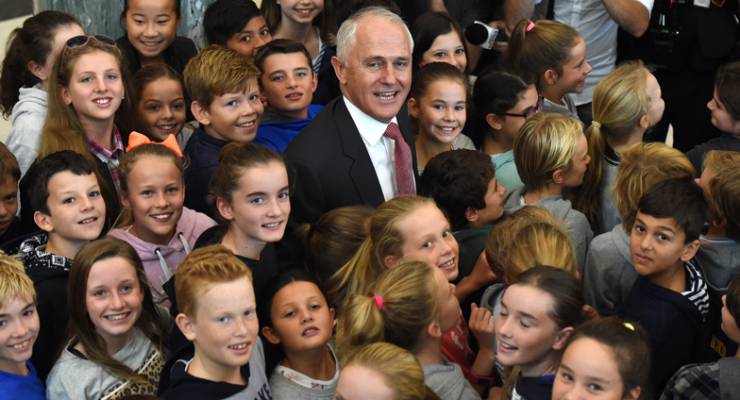
Framing is one of the most critical tools in political discourse: if you can set the terms of how voters and the media view an issue, even if it’s one that doesn’t necessarily work for you, you can blunt an opponents’ attacks or successfully attack them. In Friday night’s leaders’ debate, Malcolm Turnbull was trying to reframe the debate about banks as being about economically stability when he thought it would be smart to say that Bill Shorten wanted banks “in the dock” — only for the audience to erupt in applause at the idea of jailing bankers. Sometimes you can go a frame too far.
But framing is about more than short-term political debate: one of the most successful reframings of the 20th century was by US conservatives and corporations in response to concerns about the massive damage being inflicted on the American environment by companies. They reframed the issue of environmental damage as being about “jobs versus the environment” — a fictitious claim that protecting the environment would cost jobs and economic growth. It was extraordinarily successful, and that framing, of course, remains the dominant paradigm in both climate action and environmental protection debates, even as the coal mining industry collapses and investment and jobs in renewable energy surge worldwide.
In an effort to blunt Labor’s attacks on the government’s abandonment of the Gonski education funding reforms, the Coalition has for a long time been trying to reframe the education funding issue away from money, insisting that Australia’s declining educational performance was unrelated to the level of investment and that merely increasing funding wasn’t going to fix it.
Problematically for that reframing, however, it needed an answer to the inevitable question “well, what will fix it?”. To answer that semi-coherently, the government needed to make another of the many backflips it has made in this area: national control of standards, reporting and testing in schools was restored as a central part of government policy, despite the Abbott government making it a point of pride to have abandoned similar requirements planned by the Gillard government as “Canberra command and control”. Canberra command and control was now what was required to address Australia’s declining educational performance — along with a commitment to increased funding that took the Coalition about halfway to Labor’s Gonski funding requirement, which it hoped was far enough to blunt Labor’s attacks.
The framing is fallacious, as truthful as “jobs versus the environment”. The Gonski panel’s funding recommendations were about effectively targeting educational funding at disadvantaged students who are the key reason why Australia’s overall performance on primary and secondary education has declined. The benefits of the Gonski funding model will come disproportionately from improving outcomes for students from low socio-economic backgrounds, from rural and regional schools and indigenous communities and students with disabilities, rather than lifting the overall level of school funding.
Last week The Australian launched a concerted attack on Labor over its school funding plans that reinforced the government’s attempt to reframe the issue: additional spending on education would not provide any “immediate” impact on economic growth. Curiously, when the government, right before the budget, announced its own increase in schools funding to try to blunt Labor’s Gonski-based attack, there was no forensic analysis in the pages of the national broadsheet of its claim that the additional funding would “increase productivity, drive innovation and support our transition to a stronger and more diversified economy.”
Nor has there been any dissection by The Australian of the government’s claims about the economic benefits of its $48 billion company tax cut; quite the opposite, in fact, with articles spruiking its benefits, despite the budget papers acknowledging they would be negligible.
This is another example of how the Liberal Party, which one could legitimately hope to fully embrace neoliberalism ahead of a party like Labor, instead lapses into crony capitalism. Rather than seeing investment in education as a critical means for ensuring future workers and employers can take advantage of economic opportunities and live individualist lives free of dependence on government, the federal Liberals prefer to target Commonwealth funding at private schools, which bear little of the burden of educating disadvantaged students, because of the party’s strong links with private schools.
But so far, disadvantaged students have been “reframed” out of the debate, despite being central to the rationale for the Gonski funding reforms.








The Coalition underestimates the intelligence of the public in relation to how the education debate is perceived. Gonski was so well explained when it was launched by Labor that everyone got it – got that it was fair; got that it was targeted at precisely the right demographic and got that education is a deeper concept than getting the low socio-economic groups factory ready. The coalition can try to reframe the debate to its heart’s content, but in this debate the public is way ahead of it. Scomo’s mean-spirited budget is oozing puss from the thousand cuts it is visiting on the people least able to bear it and more and more, the public sees it as Abbot revisited.
You have to wonder if the public needs a reminder of what Gonski actually brought to the table, rather than just be this big, mean thing that the glorious LNP obliterated for the benefit of all mankind.
Funding public schools to the full extent of people’s needs is not a neoliberal idea.
Well if money isn’t the answer why do private schools need any at all? No not a clever response at all.
If our declining education performances can’t be addressed by more money (as is their standard argument) – does it necessarily follow they’d be addressed by less – which seems to be their goal?
Neo-liberalism and crony-capitalism are a false opposition, they’re two sides of the same coin.